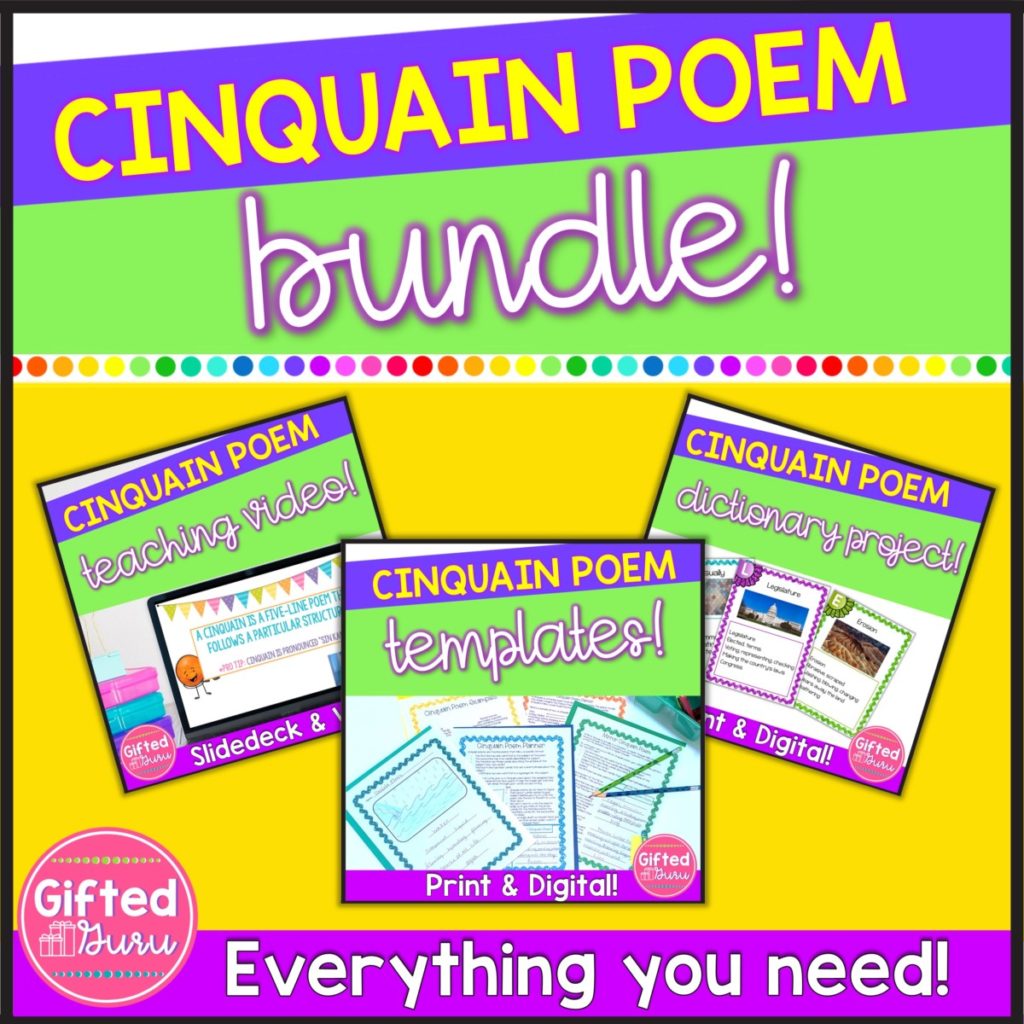Even when I’m teaching science or math, my English degree means that I love using poetry and literature to teach every content area. Cinquain poems are one of my favorite things to use to get students connected deeply to the concept we’re studying.
Cinquain poems are perfect for teaching vocabulary because they’re short, student-friendly, and focused.
What are cinquain poems?
Cinquain is one term for a five-line poem, usually a specific structure of five-line poem created by American poet Adelaide Crapsey. She was influenced by Japanese poetic forms like haiku and tanka.
At first, the version Crapsey developed required the syllables to be stressed a certain way. If you’re not familiar with it, stress means the emphasis we put on words or syllables.
Cinquains have changed a little bit, and now they usually have a set number of syllables.
| first line | two syllables |
| second line | four syllables |
| third line | six syllables |
| fourth line | eight syllables |
| fifth line | two syllables. |
Cinquain Poems in the Classroom
In school, we most often use a form of cinquain poems called didactic, meaning “learning.”
Didactic cinquains are structured like this:
- The first line is a single word that is the subject and title of the poem.
- The second line is two adjectives that describe the word in the first line.
- The third line has three words that do one of two things. They either tell more about the subject of the poem or they show action. It’s common for these words to end in -ing.
- The fourth line has four words. These words show emotion or attitude or further describe the subject. They can be a phrase (rather than be a list of words).
- The fifth line is a synonym of the title or a related word.
Here’s a science example:

raindrop
tear-shaped, wet
falling, splashing, soaking
bringing green, vibrant life
precipitation
Here’s a math example:
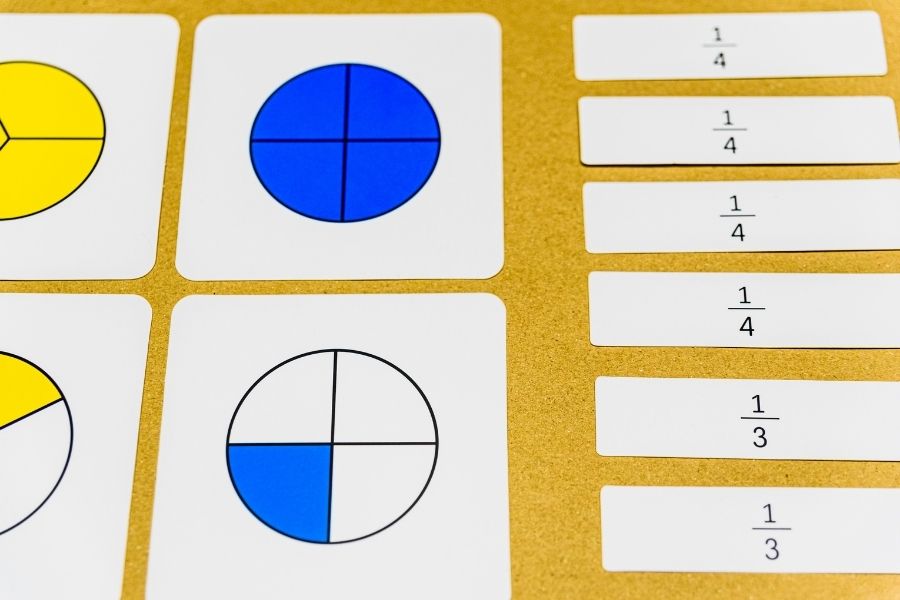
Fractions
Numerator, denominator
Dividing, parting, breaking
Equal parts of whole
Segments
The predictive, sing-songy nature of a cinquain is perfect for students, and works wonderfully with vocabulary.
How to teach vocabulary with cinquain poems
Cinquain poems are a great exercise by themselves in a Language Arts class. In other content areas, they are perfect for teaching vocabulary. (Of course, ELA teachers can use cinquains to teach vocabulary, too!)
Here are some ideas for using this simple poetic style to teach vocabulary.
Have Students Create Cinquain Poems with Target Vocabulary Words
The most straightforward way to use cinquain poems to teach vocabulary is simply to have students create cinquain poems of the target word.
Here’s a social studies example of what I mean.
The teacher says:
- We’re going to write a poem called a cinquain poem to help us learn our vocabulary words. In a cinquain poem, you have five lines.
- The first line is a single word that serves as the title of the poem. [Democracy]
- The second line is two words that describe the word in the first line. [Direct, indirect]
- The third line has three words that do one of two things. They either tell more about the subject of the poem or they show action. Use -ing words. [Voting, representing, limiting]
- The fourth line has four words. These words show emotion about the subject. They can be a phrase or form a sentence (rather than be a list of words). [Majority rule, minority rights]
- The fifth line is a synonym of the title or a word that’s similar to it. [Freedom]
You can choose if you want to capitalize the words or not. That’s a writer’s style choice (unless a word is a proper noun that should be capitalized).
You can also choose how to punctuate them as well. There are no hard-and-fast rules.
Once you’ve shared the example, work together as a class to create an example together. Then, have students work independently or in pairs to create one.
Optionally, you can then compile all of the created poems to share with all students. If you have students create the cinquains in a shared document, you can easily have them see each other’s poems.
Note: The subject of a cinquain is typically a noun. It’s difficult to write a cinquain about an adjective or adverb, especially, so it works best for vocabulary words that are nouns.
If you would like to have me teach it, I have a student-facing video you can play in class (or link to) that will explain cinquains to your students. There’s also a slidedeck in case you would like to do the instruction yourself and would like a (gorgeous) slidedeck to use.
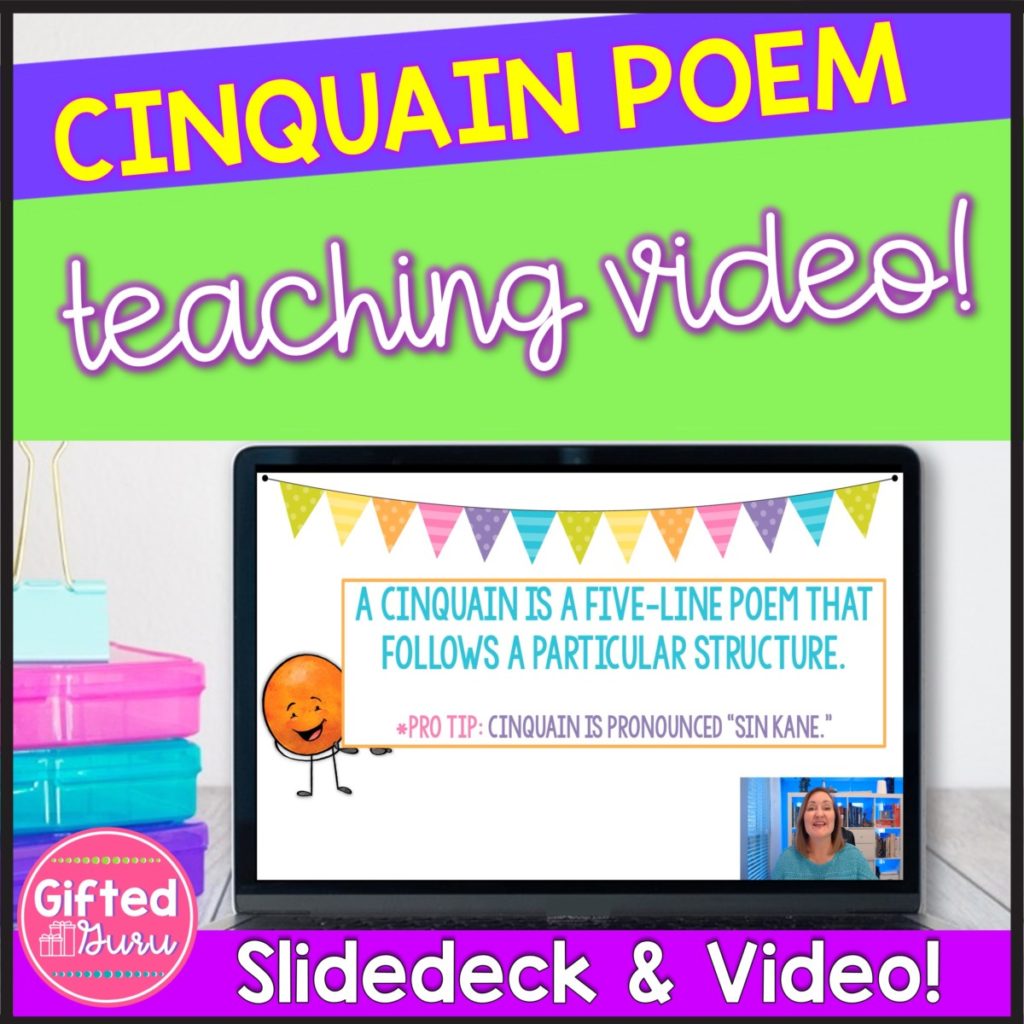
Publish a cinquain poem dictionary
Another option to use cinquain poems to teach vocabulary is to have students create a dictionary of vocabulary words where each entry is a cinquain poem. When this is done, students should be sure to add an image that they create or find.
This can be done in a few ways.
- You can have students write their cinquains on paper and then bind them in a simple notebook or with a spiral binding.
- You can have the students create their poems on PowerPoint slides (or similar) and then save them as a pdf. You can then print and bind them as you would had they created them on paper, or you can make the collection available digitally.
- A third option is to use Google Slides to have students create a dictionary slide deck. You can create your own, or you can get the one I created for you to use in print or digital formats.
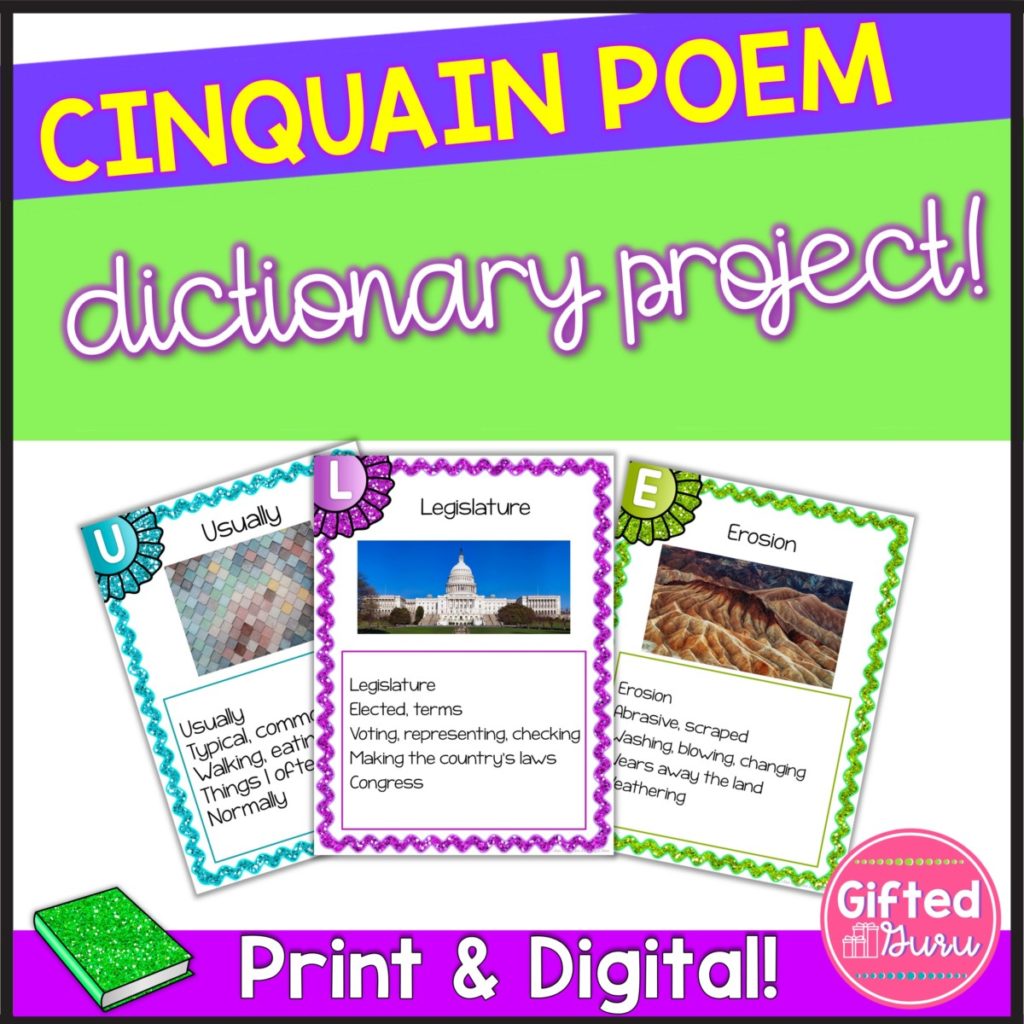
Have Students Guess the Vocabulary Word from the Cinquain Poem
Another option is to have the students create cinquain poems, leaving the first line blank. Other students then guess what word goes in the first line.
There are a few variations on this:
- You can have them trade with another student and guess each other’s first line/target word.
- You can show the poems to the class and let the class guess.
- You can create cinquains and let the students guess the words. This is a particularly good option for beginning experiences for students who need additional support.
Get Your Cinquain Poem Kit
I’ve mentioned the dictionary and instructional video already. They are part of a Cinquain Poem Kit I created that has everything you need to use cinquain poems to teach vocabulary. You can use the entire kit, or any one of the individual components.
The Cinquain Poem Kit includes:
- A student-facing video you can use to teach cinquains to your students. It includes the slidedeck, too, in case you prefer to do the direct instruction yourself. Learn more here.
- Multiple cinquain poem templates for students to use to create their own cinquain poem in both printable and Google Slide™ versions, a rubric, planning sheets, and a reflection activity. Learn more here.
- A template for a dictionary students can create that you can view virtually or print. Learn more here.
I spent a long time making sure it’s the best thing on the internet about cinquains, and I hope you love it!
Different Varieties of Cinquain Poems
Up until this point, we’ve been looking at standard cinquain poems, but there are other variations you may like to explore. This is a great way to differentiate for your high-ability learners. All of the activities described above will work with these cinquain forms, too. Let’s look at some of the possibilities!
Didactic Cinquain Poem
We’ve been working with a fairly common didactic cinquain poem form, and there’s another didactic cinquain style as well.
The two are very similar. The only difference is that the fourth line doesn’t have to have four words. Instead, it forms a complete sentence that can have more than four words.
Here’s a didactic cinquain poem example:

Erosion
Abrasive, scraped
Washing, blowing, changing
It wears away the land and forms interesting features.
Weathering
This can be a very good choice when you want to focus on a key vocabulary word.
Reverse Cinquain Poem
As its name suggests, a Reverse Cinquain is a traditional Cinquain with the internal structure reversed.
Instead of the syllable structure being:
| first line | two syllables |
| second line | four syllables |
| third line | six syllables |
| fourth line | eight syllables |
| fifth line | two syllables |
A Reverse Cinquain has
| first line | two syllables |
| second line | eight syllables |
| third line | six syllables |
| fourth line | four syllables |
| fifth line | two syllables |
Because in school we typically use a word-count-based Didactic Cinquain, reversing those looks just a little bit different. We don’t worry about syllables. Instead, we focus on words.
A Reverse Didactic Cinquain is structured like this:
| first line | synonym or similar word |
| second line | four words (or a phrase) |
| third line | three words ending in -ing |
| fourth line | two adjectives that describe the word |
| fifth line | target word |
These work very well for things that move in reverse, counterclockwise, or backwards. For example, there are processes in the water cycle that move both ways. In social studies, civilizations rise and fall. Use a Reverse Cinquain to have students explore the words related to those types of happenings.
Here’s an example of a Reverse Didactic Cinquain:
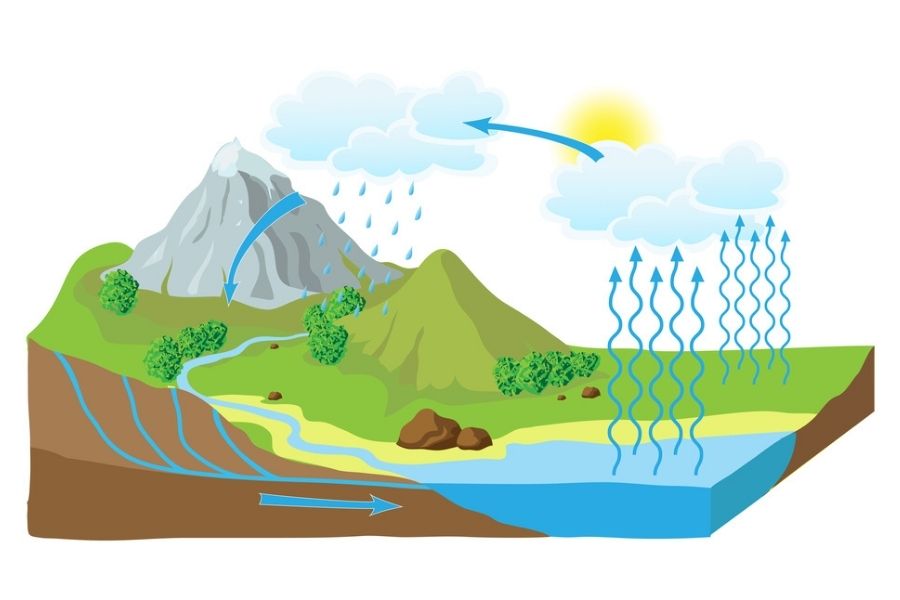
Vanishing.
Turning liquid to vapor.
Vaporizing, dissipating, diffusing.
Transition, exchange.
Evaporation.
Reverse Cinquains are great for words that are atypical or somehow unusual. Think Alice in Wonderland.
They’re also just fun because they create a kind of mini-mystery.
Mirror Cinquain Poem
A Mirror Cinquain is actually two Cinquains – a regular Cinquain followed by a Reverse Cinquain.
To make these even more fun, you can have the last line of the first Cinquain be the same word as the first word of the Reverse Cinquain.
Here’s an example using vocabulary words from the novel Island of the Blue Dolphins:
Whale
Sleak, intelligent
Breathing, blowing, sounding
Hunted for meat and blubber
Mammal
Mammal
Adapted to marine environment
Hunting, foraging, tool-using
Furry, endangered
Sea Otter
Mirror Cinquains are particularly fun to do, and they work very well when there are two related vocabulary words in a text.
A couple of options for using a Mirror Cinquain in vocabulary instruction include:
- Have half of the class create a Cinquain and the other class create a Reverse Cinquain. Let them try to find the best match and put their poems together to make a Mirror Cinquain.
- Create a Mirror Cinquain (or have students do it), leaving out the first and last words. Have students guess which vocabulary word would fit each slot.
Butterfly Cinquain Poem
Butterfly Cinquain poems are very similar to Mirror Cinquains. The difference is that while a Mirror Cinquain is two separate poems, in a Butterfly Cinquain, the poems are merged together into a single nine-line poem.
The pattern is:
| first line | one word |
| second line | two words |
| third line | three words |
| fourth line | four words |
| fifth line | one word |
| sixth line | four words |
| seventh line | three words |
| eighth line | two words |
| ninth line | one word |
Remember, I’m describing word patterns, rather than syllable patterns. If you wanted students to conform to a syllable pattern, you would double the number of words to get the correct number of syllables.
Word patterns are preferable with vocabulary words because otherwise you’d be restricted to two-syllable vocabulary words in order to fit the structure.
There are other types of Cinquains as well that are much longer (five or six Cinquains together). The ones I’ve described and shown examples of are the ones that are the best fit for vocabulary words.
Have students reflect on their cinquain poems
Reflection is an important part of the writing process, and this is true of cinquain poems. Have students reflect things like:
- The process of writing the poem
- What words were hardest to think of?
- Were they able to convey the feeling they intended to?
- If they were to write it again, what choices would they make differently?
- If they read other students’ cinquains, ask them to identify what they liked in other students’ poems.
Sharing Students’ Cinquain Poems
After the students have written their poems, compile them in a way that they can be read and appreciated.
Stapleless Books for Cinquain Poems
A great way to make small poetry books is to have students make simple stapleless books. These require nothing more than four pieces of paper, a pencil, a pair of scissors and a ruler.
They’re easy to make, but hard to describe, so you may wish to watch this video that shows the process.
Using Google Slides™ or Jamboard to Share Cinquain Poems
All of the Google products work well for sharing cinquain poems, especially Google Slides and Jamboard. Because they work more easily with images and textboxes, I recommend them over Docs.
To use Google Slides, you can create a class slidedeck with a slide for each student. Put their name in the “Speaker Notes” section below the slide so they know which slide to use. Optionally, you can have them insert an image to reflect the poem’s subject.
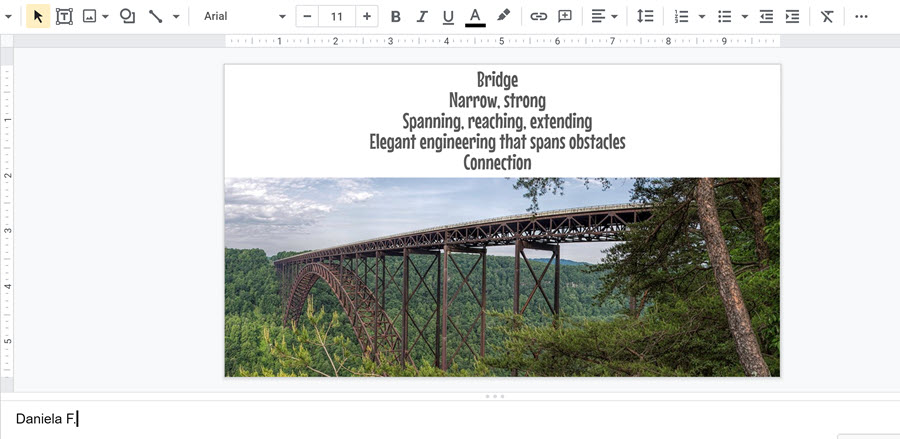
For Jamboard, the maximum number of frames is 20, so you can either:
- Create multiple Jamboards
- Have more than one poem per Jamboard
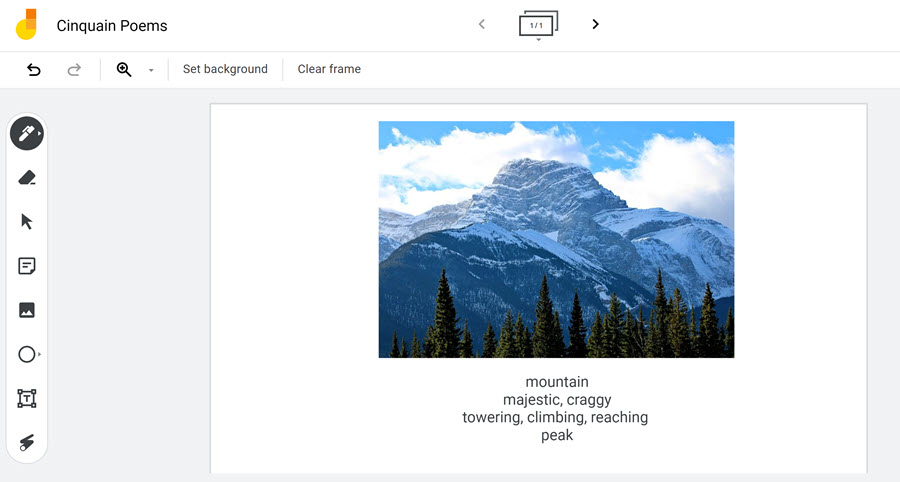
Wrapping Up:
Cinquain poems are a wonderful vocabulary exercise because they invite creativity, broader thinking, enrich language experience, and help students develop a deeper attachment to the word.
Because they can take time to create, they keep students focused on the target word longer. With vocabulary, longer is better.
We know that best practices in vocabulary instruction include multiple, varied experiences with the word, and Cinquains are a perfect option for helping this happen.
You May Also Like:
So many of the articles on the site have free downloads! Poke around and grab all the goodies to make teaching vocabulary fun and effective!
Here are a few you might like:
- Playing with Concept Cubes to Teach Vocabulary
- Using the Frayer Model to Teach Vocabulary
- Harry Potter Sorting Hat Vocabulary Strategy
- Ideas for Using Twitter to Teach Vocabulary
If you would like the Cinquain Poem Kit, you can find that here.

